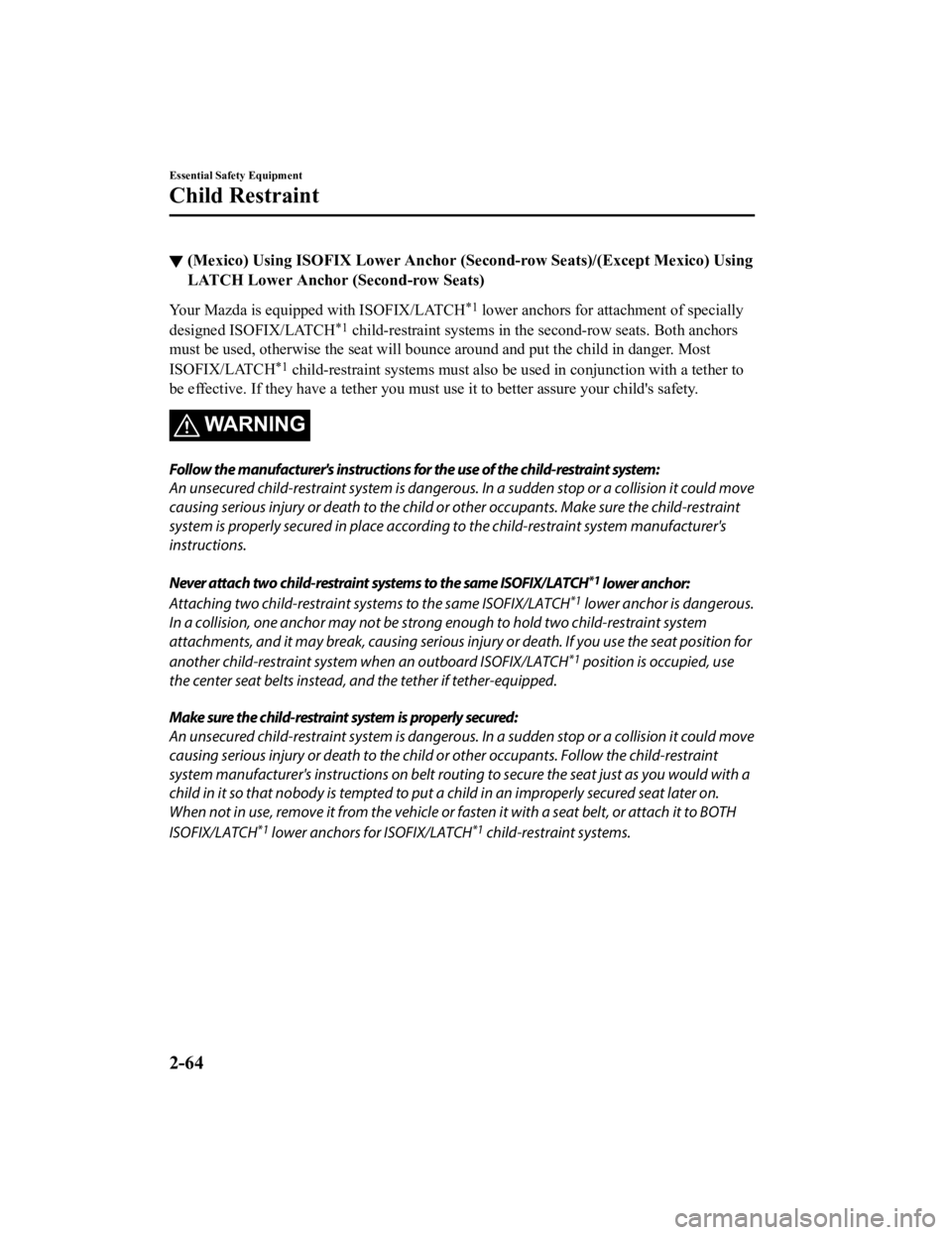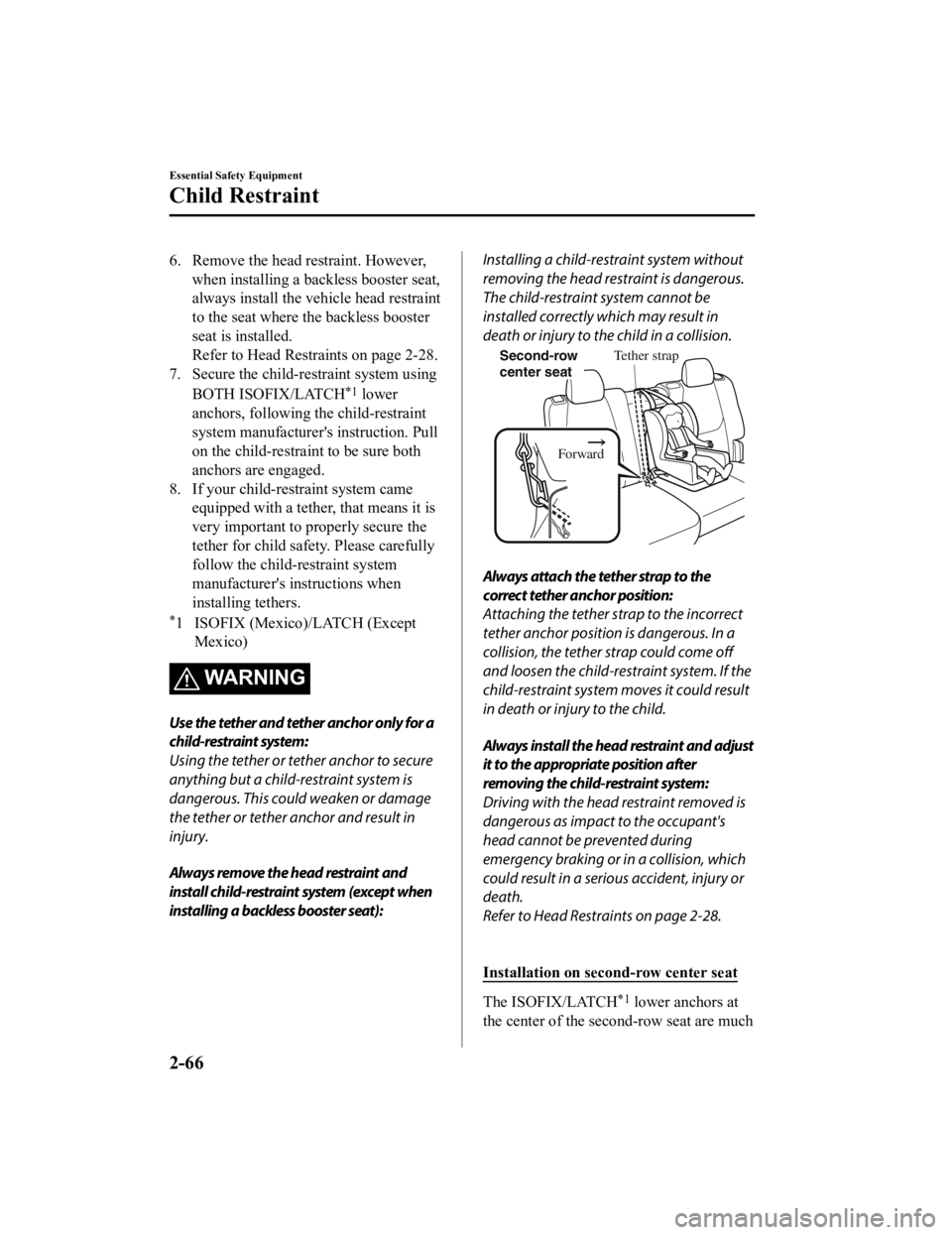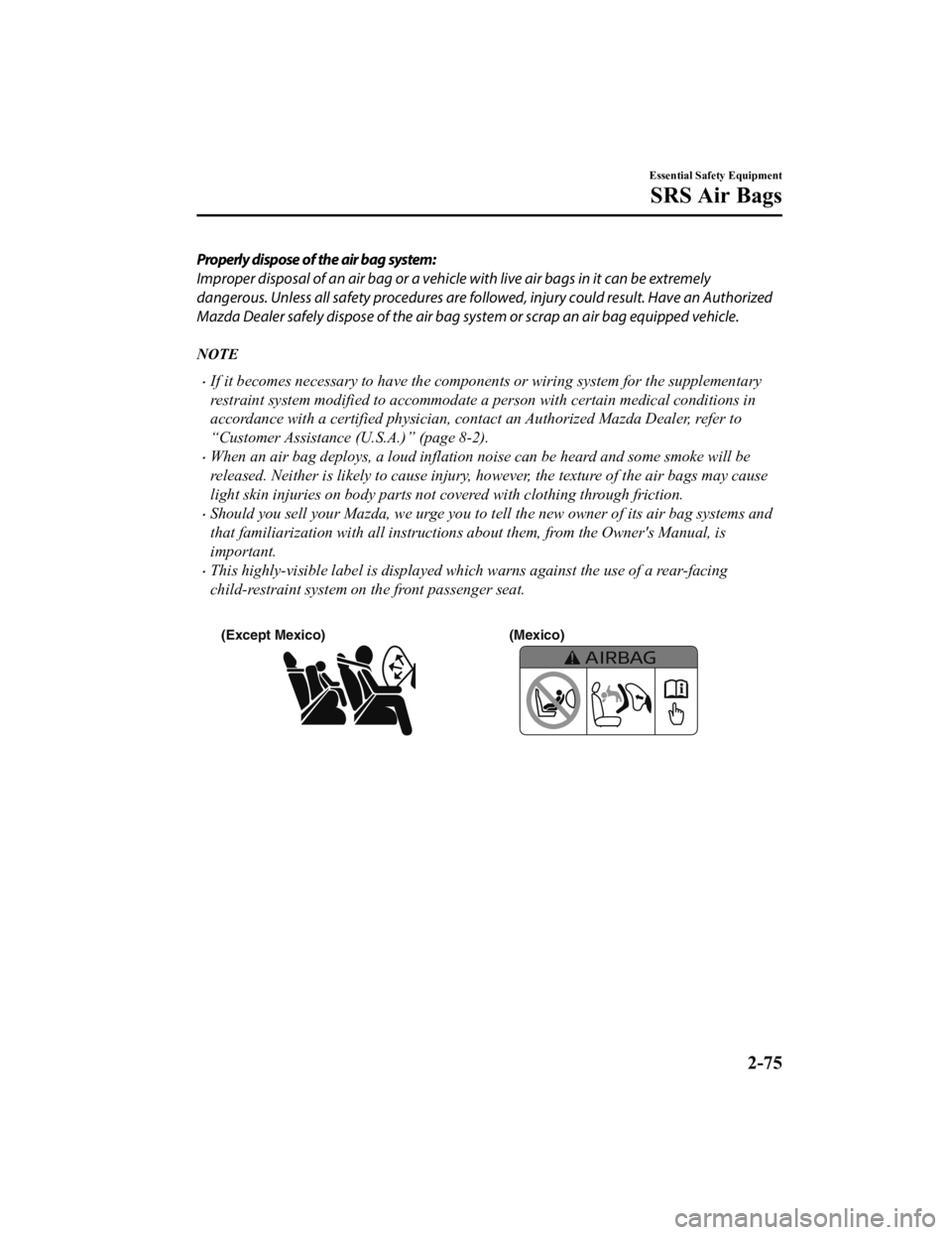child restraint MAZDA MODEL CX-9 2022 Owner's Guide
[x] Cancel search | Manufacturer: MAZDA, Model Year: 2022, Model line: MODEL CX-9, Model: MAZDA MODEL CX-9 2022Pages: 715, PDF Size: 81.06 MB
Page 77 of 715

▼(Mexico) Using ISOFIX Lower Anchor (Second-row Seats)/(Except M
exico) Using
LATCH Lower Anchor ( Second-row Seats)
Your Mazda is equipped with ISOFIX/LATCH*1 lower anchors for attachment of specially
designed ISOFIX/LATCH
*1 child-restraint systems in the second-row seats. Both anchors
must be used, otherwise the seat will bounce around and put the child in danger. Most
ISOFIX/LATCH
*1 child-restraint systems must also be used in conjunction with a tether to
be effective. If they have a tether you must use it to better assure your child's safety.
WA R N I N G
Follow the manufacturer's instructions for the use of the child-restraint system:
An unsecured child-restraint system is dangerous. In a sudden stop or a collision it could move
causing serious injury or death to the child or other occupants. Make sure the child-restraint
system is properly secured in place according to the child-restraint system manufacturer's
instructions.
Never attach two child-restraint systems to the same ISOFIX/LATCH
*1 lower anchor:
Attaching two child-restraint systems to the same ISOFIX/LATCH
*1 lower anchor is dangerous.
In a collision, one anchor may not be strong enough to hold two child-restraint system
attachments, and it may break, causing serious inju ry or death. If you use the seat position for
another child-restraint system when an outboard ISOFIX/LATCH
*1 position is occupied, use
the center seat belts instead, and the tether if tether-equipped.
Make sure the child-restraint system is properly secured:
An unsecured child-restraint system is dangerous. In a sudden stop or a collision it could move
causing serious injury or death to the child or other occupants. Follow the child-restraint
system manufacturer's instructions on belt routing to secure the seat just as you would with a
child in it so that nobody is tempted to put a child in an improperly secured seat later on.
When not in use, remove it from the vehicle or fa sten it with a seat belt, or attach it to BOTH
ISOFIX/LATCH
*1 lower anchors for ISOFIX/LATCH*1 child-restraint systems.
Essential Safety Equipment
Child Restraint
2-64
CX-9_8KH5-EA-21K_Edition2_old 2021-9-16 14:11:22
Page 78 of 715

Make sure there are no seat belts or foreign objects near or around the ISOFIX/LATCH*1
child-restraint system:
Not following the child-restraint system manufacturer's instructions when installing the
child-restraint system is dangerous. If seat be lts or a foreign object prevent the child-restraint
system from being securely attached to the ISOFIX/LATCH
*1 lower anchors and the
child-restraint system is installed improperly , the child-restraint system could move in a
sudden stop or collision causing serious injury or death to the child or other occupants. When
installing the child-restraint system, make sure there are no seat belts or foreign objects near
or around the ISOFIX/LATCH
*1 lower anchors. Always follow the child-restraint system
manufacturer's instructions.
*1 ISOFIX (Mexico)/LATCH (Except Mexico)
Installation on second-row outboard
seats
1. First, adjust the front seat to allow clearance between the child-restraint
system and the front seat.
Refer to Adjusting the Driver's Seat on
page 2-5.
Refer to Adjusting the Front
Passenger's Seat on page 2-13.
2. Adjust the second-row seat position using the following procedure.
Fold the second-row seatback
forward.
Raise the second- row seatback until
a click sound is heard and it is locked
in place.
3. Adjust the angle of the second-row seatback so that there is no gap
between the child-re straint system and
the second-row seatback.
4. Make sure the seatback is securely latched by pushing it back until it is
fully locked.
5. Remove the cover of the child-restraint
system's ISOFIX/LATCH
*1 lower
anchors to verify the locations of the
ISOFIX/LATCH
*1 lower anchors.
Lower anchor Type A Type B
NOTE
The ISOFIX/LATCH*1 lower
anchors marking on the cover
indicates the position of the ISOFIX/
LATCH
*1 lower anchors for the
attachment of a child-restraint
system.
Store the removed cover so that it
does not get lost.
Essential Safety Equipment
Child Restraint
2-65
CX-9_8KH5-EA-21K_Edition2_old 2021-9-16 14:11:22
Page 79 of 715

6. Remove the head restraint. However,when installing a backless booster seat,
always install the vehicle head restraint
to the seat where the backless booster
seat is installed.
Refer to Head Restra ints on page 2-28.
7. Secure the child-restraint system using
BOTH ISOFIX/LATCH
*1 lower
anchors, following the child-restraint
system manufacturer's instruction. Pull
on the child-restrain t to be sure both
anchors are engaged.
8. If your child-restraint system came equipped with a tether, that means it is
very important to properly secure the
tether for child safety. Please carefully
follow the child-restraint system
manufacturer's instructions when
installing tethers.
*1 ISOFIX (Mexico)/LATCH (ExceptMexico)
WA R N I N G
Use the tether and tether anchor only for a
child-restraint system:
Using the tether or tether anchor to secure
anything but a child-restraint system is
dangerous. This could weaken or damage
the tether or tether anchor and result in
injury.
Always remove the head restraint and
install child-restraint system (except when
installing a backless booster seat):
Installing a child-restraint system without
removing the head restraint is dangerous.
The child-restraint system cannot be
installed correctly which may result in
death or injury to the child in a collision.
Tether strap
Forward
Second-row
center seat
Always attach the tether strap to the
correct tether anchor position:
Attaching the tether strap to the incorrect
tether anchor position is dangerous. In a
collision, the tether strap could come off
and loosen the child-restraint system. If the
child-restraint system moves it could result
in death or injury to the child.
Always install the head restraint and adjust
it to the appropriate position after
removing the child-restraint system:
Driving with the head restraint removed is
dangerous as impact to the occupant's
head cannot be prevented during
emergency braking or in a collision, which
could result in a serious accident, injury or
death.
Refer to Head Restraints on page 2-28.
Installation on second-row center seat
The ISOFIX/LATCH*1 lower anchors at
the center of the second-row seat are much
Essential Safety Equipment
Child Restraint
2-66
CX-9_8KH5-EA-21K_Edition2_old 2021-9-16 14:11:22
Page 80 of 715

further apart than the sets of ISOFIX/
LATCH
*1 lower anchors for child-restraint
system installation at other seating
positions. Child-restraint systems with
rigid ISOFIX/LATCH
*1 attachments
cannot be installed on the center seating
position. Some ISOFIX/LATCH
*1
equipped child-restraint systems can be
placed in the center position and will reach
the nearest ISOFIX/LATCH
*1 lower
anchors which are 500 mm (19.7 in) apart.
ISOFIX/LATCH
*1 compatible
child-restraint syste ms (with attachments
on belt webbing) can be used at this
seating position only if the child-restraint
system manufacturer's instructions state
that the child-restraint system can be
installed to ISOFIX/LATCH
*1 lower
anchors that are 500 mm (19.7 in) apart.
Do not attach two child-restraint systems
to the same ISOFIX/LATCH
*1 lower
anchor. If your child-restraint system has a
tether, it must also be used for your child's
optimum safety.
The procedure for installation on the rear
outboard seats is the same.
*1 ISOFIX (Mexico)/LATCH (Except Mexico)
ISOFIX/LATCH*1 lower anchor
location
WA R N I N G
Always remove the head restraint and
install child-restraint system (except when
installing a backless booster seat):
Installing a child-restraint system without
removing the head restraint is dangerous.
The child-restraint system cannot be
installed correctly which may result in
death or injury to the child in a collision.
Tether strap
Forward
Second-row
center seat
Essential Safety Equipment
Child Restraint
2-67
CX-9_8KH5-EA-21K_Edition2_old
2021-9-16 14:11:22
Page 81 of 715

Always attach the tether strap to the
correct tether anchor position:
Attaching the tether strap to the incorrect
tether anchor position is dangerous. In a
collision, the tether strap could come off
and loosen the child-restraint system. If the
child-restraint system moves it could result
in death or injury to the child.
Always install the head restraint and adjust
it to the appropriate position after
removing the child-restraint system:
Driving with the head restraint removed is
dangerous as impact to the occupant's
head cannot be prevented during
emergency braking or in a collision, which
could result in a serious accident, injury or
death.
Refer to Head Restraints on page 2-28.
*1 ISOFIX (Mexico)/LATCH (ExceptMexico)
Essential Safety Equipment
Child Restraint
2-68
CX-9_8KH5-EA-21K_Edition2_old 2021-9-16 14:11:22
Page 83 of 715

Hold the driver in a position which allows better control of the vehicle.
If your vehicle is also equipped with a front passenger occupant classification system,
refer to the Front Passenger O ccupant Classification System (pa ge 2-85) for details.
If your vehicle is equipped with a front passenger occupant cla ssification system, the front
passenger air bag deactivation indicator light illuminates for a specified time after the
ignition is switched ON.
Small children must be protected by a child-restraint system as stipulated by law in every
state and province. In certain states and provinces, larger chi ldren must use a child-restraint
system (page 2-44).
Carefully consider whic h child-restraint system is necessary fo r your child and follow the
installation directions in this Owner's Manual as well as the c hild-restraint system
manufacturer's instructions.
Essential Safety Equipment
SRS Air Bags
2-70
CX-9_8KH5-EA-21K_Edition2_old 2021-9-16 14:11:22
Page 84 of 715

WARNING
Seat belts must be worn in air bag equipped vehicles:
Depending only on the air bags for protection during an accident is dangerous. Alone, air
bags may not prevent serious injuries. The appropriate air bags can be expected to inflate
only in the first accident, such as frontal, near frontal or side collisions or roll-over accidents
that are at least moderate. Vehicle occu pants should always wear seat belts.
Children should not ride in the front passenger seat:
Placing a child, 12 years or under, in the front seat is dangerous. The child could be hit by a
deploying air bag and be seriously injured or ev en killed. A sleeping child is more likely to lean
against the door and be hit by the side air ba g in moderate collision to the front-passenger
side of the vehicle. Whenever possible, always secure a child 12 years and under on the rear
seats with an appropriate child-restraint system for the child's age and size.
Never use a rear-facing child-restraint system in the front seat with an air bag that could
deploy:
Rear-facing child-restraint systems on the front seat are particularly dangerous even though
you may feel assured that a front passenger air bag will not deploy based on the fact that the
front passenger air bag deactivation indicato r light illuminates. The child-restraint system
can be hit by a deploying air bag and moved viol ently backward resulting in serious injury or
death to the child.
Do not sit too close to the driver and front passenger air bags:
Sitting too close to the driver and front passenger air bag modules or placing hands or feet on
them is extremely dangerous. The driver and front passenger air bags inflate with great force
and speed. Serious injuries could occur if someon e is too close. The driver should always hold
onto only the rim of the steering wheel. The front seat passenger should keep both feet on the
floor. Front seat occupants should adjust their seats as far back as possible and always sit
upright against the seatbacks with seat belts worn properly.
Essential Safety Equipment
SRS Air Bags
2-71
CX-9_8KH5-EA-21K_Edition2_old 2021-9-16 14:11:22
Page 88 of 715

Properly dispose of the air bag system:
Improper disposal of an air bag or a vehicle with live air bags in it can be extremely
dangerous. Unless all safety procedures are followed, injury could result. Have an Authorized
Mazda Dealer safely dispose of the air bag sy stem or scrap an air bag equipped vehicle.
NOTE
If it becomes necessary to have the components or wiring system for the supplementary
restraint system modified to accommodate a person with certain medical conditions in
accordance with a certified physician, contact an Authorized Mazda Dealer, refer to
“Customer Assistance (U.S.A.)” (page 8-2).
When an air bag deploys, a loud inflation noise can be heard and some smoke will be
released. Neither is likely to cause injury, however, the texture of the air bags may cause
light skin injuries on body parts not covered with clothing through friction.
Should you sell your Mazda, we urge you to tell the new owner of its air bag systems and
that familiarization with all instructi ons about them, from the Owner's Manual, is
important.
This highly-visible label is displayed which warns against the use of a rear-facing
child-restraint system on the front passenger seat.
(Except Mexico) (Mexico)
Essential Safety Equipment
SRS Air Bags
2-75
CX-9_8KH5-EA-21K_Edition2_old 2021-9-16 14:11:22
Page 99 of 715

If the front passenger occupant classification sensor is normal, the indicator light turns on
when the ignition is switched ON. The light turns off after a few seconds. Then, the
indicator light turns on or is off under the following conditio ns:
Front passenger air bag deactiva tion indicator light on/off condition chart
Condition detected by the front
passenger occupant classifica‐ tion system Front passenger air
bag deactivation indi‐ cator light Front passenger front
and side air bags Front passenger seat
belt pretensioner sys‐ tem
Empty (Not occupied) OnDeactivated Deactivated
A child less than 1 year old is
seated in a child-restraint system On
Deactivated Deactivated
Child
*1On or off Deactivated or ready Deactivated or ready
Adult
*2Off Ready Ready
*1 The occupant classification sens or may not detect a child seated on the seat, in a child-restraint system, or a
junior seat depending on the ch ild's physical size and seated posture.
*2 If a smaller adult sits on the front passenger seat, the sensors might detect the person as being a child
depending on the person's physique.
The curtain air bag is ready for inflating regardless of what the front passenger air bag
deactivation indicator light on/off condition chart indicates.
If the front passenger air bag deactivation indicator light doe s not turn on when the ignition
is switched ON and does not turn on as indicated in the front p assenger air bag deactivation
indicator light on/off condition chart, do not allow an occupan t to sit in the front passenger
seat and consult an Authorized M azda Dealer as soon as possible. The system may not work
properly in an accident.
WA R N I N G
Do not allow an occupant in the front passenger's seat to sit with a posture which makes it
difficult for the front passenger occupant
classification sensor to detect the occupant
correctly:
Sitting in the front passenger's seat with a posture which makes it difficult for the front
passenger occupant classification sensor to dete ct the occupant correctly is dangerous. If the
front passenger occupant classification sensor ca nnot detect the occupant sitting on the front
passenger's seat correctly, the front passenge r front and side air bags and pretensioner
system may not operate (non-deploy) or they may operate (deploy) accidentally. The front
passenger will not have the su pplementary protection of the air bags or the accidental
operation (deployment) of the air bags co uld result in serious injury or death.
Under the following conditions, the front passe nger occupant classification sensor cannot
detect a passenger sitting on the front passe nger's seat correctly and the deployment/
non-deployment of the air bags cannot be contro lled as indicated in the front passenger air
bag deactivation indicator light on /off condition chart. For example:
Essential Safety Equipment
SRS Air Bags
2-86
CX-9_8KH5-EA-21K_Edition2_old 2021-9-16 14:11:22
Page 100 of 715

A front passenger is seated as shown in the following
figure:
A rear passenger pushes up on the front passenger seat with their feet.
Luggage or other items placed under the front passenger seat or between the front
passenger seat and driver seat that push up the front passenger seat bottom.
An object, such as a seat cushion, is put on the front passenger's seat or between the
passenger's back and the seatback.
A seat cover is put on the front passenger's seat.
Luggage or other items are placed on the seat with the child in the child-restraint system.
A rear passenger or luggage push or pull down on the front passenger seatback.
Luggage or other items are placed on the seatback or hung on the head restraint.
The seat is washed.
Liquids are spilled on the seat.
The front passenger seat is moved backward, pushing into luggage or other items placed
behind it.
The front passenger seatback contacts the rear seat.
Luggage or other items are placed between the front passenger seat and driver seat.
An electric device is put on the front passenger's seat.
An additional electrical device, such as a seat warmer is installed to the surface of the front
passenger seat.
Essential Safety Equipment
SRS Air Bags
2-87
CX-9_8KH5-EA-21K_Edition2_old 2021-9-16 14:11:22